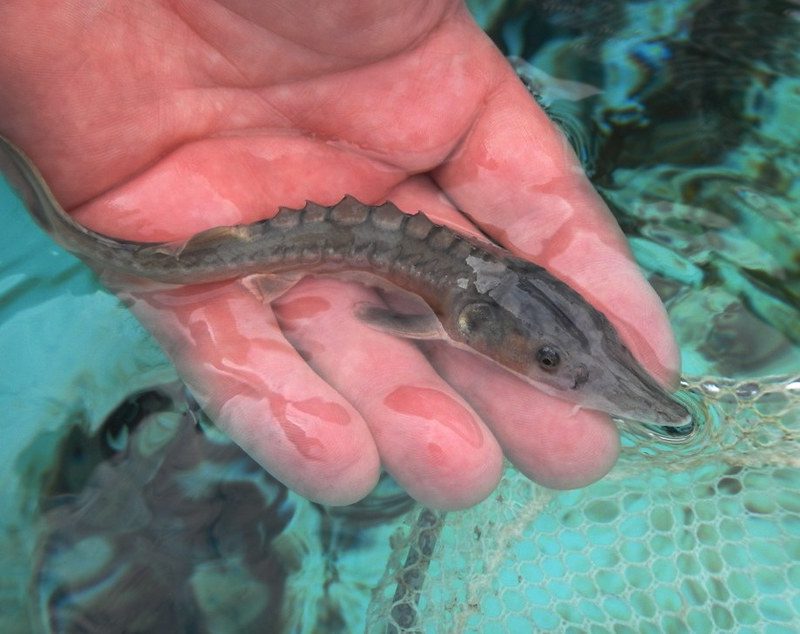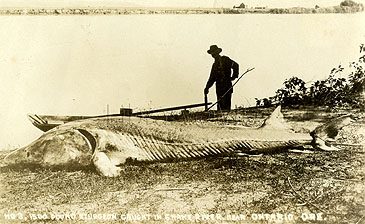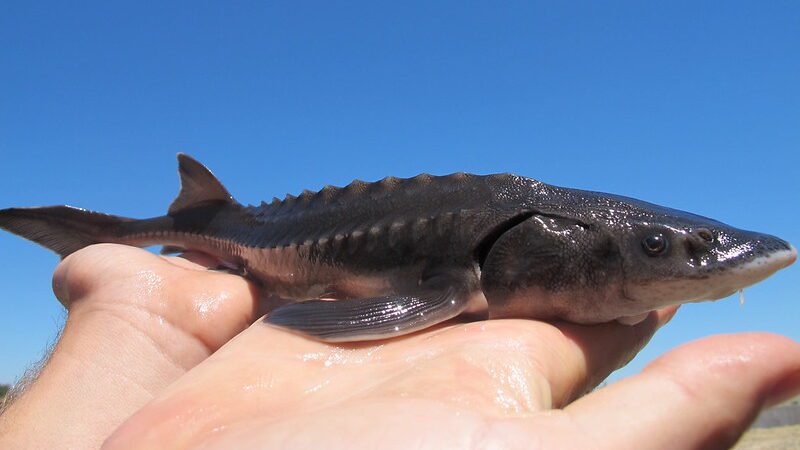Monday July 31, 2023

Sturgeon are an ancient family of fish much older than those we typically see behind the deli counter. The sturgeon family first evolved in the Jurassic period, nearly 200 million years ago. To put that in perspective, dinosaurs were walking the earth while sturgeon were swimming in oceans and rivers. If that isn’t impressive enough, sturgeon can exceed 100 years in age and historic accounts suggest that the largest individual ever caught may have been a beluga sturgeon (Huso huso) at 24 feet long and weighing over 3,000 pounds – almost four times the height of Shaquille O’Neal and nearly the same weight as a Tesla Model 3. Adult sturgeon are toothless bottom feeders that consume invertebrates and fish off the river or ocean floor and are covered in scutes, creating an armor plating, protecting them from predators that lurk in the water. These scutes are modified ganoid scales that are not ideal for typical scale aging practices. Therefore, sturgeon are generally aged by looking at small clips from their pectoral fin spine, which have annual layers that can be read like the rings of a tree. Sturgeon mature late in life (between 5 and 30 years depending on the species) and can live exclusively in freshwater habitats or move between freshwater and marine waters. They reproduce in freshwater, following lengthy migrations, often traveling hundreds of miles to spawn.

Worldwide, there are over 25 species of sturgeon that can be found across Europe, Asia, and North America. With the exception of the Yangtze sturgeon (Acipenser dabryanus), which is extinct in the wild, all other species assessed by the International Union for Conservation of Nature are classified as threatened to critically endangered. These classifications have earned sturgeon the unfortunate superlative as the family of animals most at risk of extinction. In Europe and Asia, all sturgeon species have an endangered or critically endangered status except for the Atlantic sturgeon (Acipenser oxyrhynchus oxyrhynchus) which, although presumably extirpated from their European range, persists in North America. However, there is hope. A young Adriatic sturgeon (Acipenser naccarii) was recently discovered in the River Po in Italy, renewing possibilities that natural reproduction is still viable for this population. This discovery also led to a change in the listing of Adriatic sturgeon from extinct in the wild to critically endangered. Recovery efforts in North America largely began before populations reached the verge of extinction and, as a result, these fish generally face a less dire situation than their counterparts on other continents. Of the eight species native to North America, only Alabama (Scaphirhyncus suttkusi), green (Acipenser medirostris), lake (Acipenser fulvescens), and pallid (Scaphirhynchus albus) sturgeon are considered endangered or critically endangered while the remaining four are classified as vulnerable. California even has permitted sport fishing and harvest for white sturgeon.

A laundry list of human-driven factors contributes to sturgeon decline including pollution, habitat fragmentation, and overfishing. With the progression of worldwide agricultural and industrial development, dams became more prevalent to create reservoirs, sources of hydroelectric power, and options for irrigation. Dams interrupt the natural flow of rivers, change water temperatures, and reduce habitat connectivity which are all critical for the natural reproduction of sturgeon species. Sturgeon reproduction is hampered by the construction of dams in their residential reaches as they require uninterrupted stretches of flowing water for their larvae to drift and mature. In addition to dam construction, humans have historically overharvested sturgeon for their eggs, also known as caviar, to consume as a delicacy. Even though sturgeon farming practices and harvest restrictions were implemented to prevent the overharvesting of wild fish for caviar, many challenges to sturgeon survival persist. Though circumstances for these ancient fish seem grim, worldwide efforts are in place to prevent the extinction of these gentle giants. Conservation propagation and stocking efforts have been implemented for nearly every sturgeon species to increase the number of fish in their native ranges. Velociraptors and Tyrannosaurus rex no longer roam this earth but we have a chance to save their fishy counterparts!
This post was featured in our weekly e-newsletter, the Fish Report. You can subscribe to the Fish Report here.
